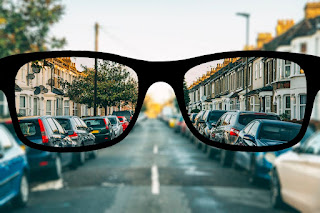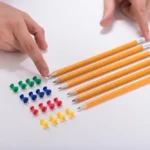
Myopia, or nearsightedness, is a common type of refractive error in which close objects appear clear but distant objects appear blurry.
According to a report published in the journal Ophthalmology in 2016, the number of people affected by nearsightedness is rapidly increasing. By 2050, approximately half of the world’s population (about 5 million people) is expected to be affected by this condition. Researchers attribute the situation primarily to a rapid change in lifestyle that includes increased use of smartphones, laptop computers, and decreased outdoor activities.
The eye in myopic people is slightly longer from front to back. This means that when you look at a distant object, the light rays will focus in front of your retina rather than on it. As a result, a blurry image is formed and transmitted to the brain, rendering the distant object blurry for you.
Myopia, also known as nearsightedness, begins to develop between the ages of 6 and 12. Teenagers’ eyeballs continue to grow, so if the child or teen has Myopia, it tends to worsen quickly at this age.
Nearsightedness is characterized by difficulty seeing distant objects or by blurred vision when looking at distant images or objects. You have myopic vision if you can see closely held objects clearly or read books without straining to see things when compared to distant objects. You may have difficulty seeing images or words on notice boards, televisions, and movie screens. As a result, poor work performance or a drop in performance at school and other tasks may result (driving or playing sports).
If you notice that your child squints or frowns when looking at distant objects, complains of headaches, and holds books and other objects close to his or her face, he or she may have Myopia.
Nearsighted children may gravitate toward TV screens or show a lack of interest in sports and other outdoor activities that require clear distance vision.
Take your child to an eye specialist if he is having difficulty seeing distant objects clearly. It is critical to diagnose and treat nearsightedness as soon as possible. It’s because, without better visual skills, your child may struggle with schoolwork and other activities that necessitate seeing distant objects.
When you focus on an object for an extended period of time, the focusing muscles in the eyes, also known as the Ciliary muscles, lock up. As a result, your eyes grow longer. Nearsightedness occurs when your eyes are overly elongated.
Myopia can be inherited. This means that if both parents are Myopic, their children are at a higher risk of developing nearsightedness.
According to a study conducted by Kathryn Rose, a visual disorders researcher at the University of Sydney’s Faculty of Health Sciences, a lack of sunlight can also cause myopia in children. Another study, conducted by the University of Western Australia, discovered that a lack of outdoor time is a risk factor for the development of nearsightedness.
People who read a lot are more likely to develop nearsightedness.
According to Professor Ian Morgan, a researcher at the Australian National University in Canberra, children become nearsighted when they spend more time in front of computers or doing activities such as reading books, watching television, or reading books.
Nearsightedness was found in 31.3% of first-year students in a study conducted by researchers at Complutense University in Spain. On the other hand, 49% of final-year students were nearsighted. According to Dr Rafaela Garrido, the research author, students usually spend a long time doing intensive near work with their eyes. People who use a computer or a microscope are doing a lot of work with their eyes. This causes severe strain on the eye, resulting in nearsightedness.
Several procedures may be used by the eye specialist to determine how your eyes focus light and the power of optical lenses that may be required to correct the problem vision.
The eye doctor will ask you to identify the letters on the chart. This test determines your visual acuity, which is typically expressed as a fraction such as 20/20. The fraction’s top number represents the standard distance over which your test was conducted (for instance, 20 feet). The fraction’s bottom number represents the smallest letter size that you have read. If your visual acuity is 20/40, you will need to get within 20 feet of a letter or letters that a person with normal vision can see clearly at 40 feet. Normal visual acuity distance is 20/20; however, people may have 20/15 vision, which is obviously better.
A phoropter may also be used by the eye specialist. An optometrist or eye specialist will place several lenses in front of your eyes. A Retinoscope will be used to measure how your eyes focus light. The eye specialist may also use an automated machine to assess your eye’s focusing power. The power is then refined based on your eyes’ responses to determine the lenses that will provide you with the clearest vision.
Before performing these tests, many eye specialists use eye drops. They may, however, perform this test without using any eye drops. They do this to see how your eyes will react under normal lighting conditions. The eye drops are used to keep your eyes from shifting focus while testing.
Your optometrist will determine whether you have myopia based on the information obtained from the test, as well as the results of other tests. The power of lens correction required for clear vision will also be determined by the optometrist.
Using Eyeglasses: For many people with myopia, this is the primary method of correcting their vision. Depending on the severity of your myopia, your doctor may advise you to wear glasses only for certain activities, such as driving or watching a movie. If you are extremely nearsighted, you may need to wear glasses all of the time.
The doctor will usually prescribe a single-vision lens to provide you with clear vision at all distances. However, if you are over 40 years old, or if the patient is a child or an adult whose myopia is caused by the stress of near-vision work, your eye doctor may recommend a bifocal or a progressive addition lens. These multifocal lenses provide different powers throughout the lens to help you see clearly at all distances.
Contact Lenses: Some people with nearsightedness use contact lenses to improve their vision. Contact lenses have a much wider field of vision than glasses. However, because you will be wearing contact lenses directly on your eyes, it is critical that you take proper care of the lenses to ensure your eye health.
Laser procedures: If you suffer from nearsightedness, your doctor may recommend laser procedures such as LASIK (Laser in-situ Keratomileusis) or PRK (photorefractive keratectomy). By removing a small portion of your eye tissue, a laser beam is used to reshape your Cornea. The amount of myopia that these procedures can correct, however, is determined by the amount of corneal tissue that can be safely removed from your eyes.
LASIK involves the removal of tissue from the inner layers of the Cornea by an eye surgeon. The surgeon does this by lifting a section of the outer corneal surface and folding it back to expose the inner tissue. The eye surgeon then uses a laser to remove a certain amount of corneal tissue that is required for reshaping your eye. The flap is then returned to its original position. All of India’s top hospitals offer LASIK eye surgery.
In the case of PRK, the doctor uses a laser to remove a thin layer of tissue from the surface of the cornea in order to change its shape and refocus light entering your eye.









